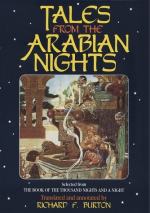[FN#25] Arab. “Ghabasah,” from Ghabas=obscure, dust-coloured.
[FN#26] Arab. “Susah"=a weevil, a moth, a worm. It does not mean simply a flaw, but a live animal (like our toads in the rock); and in the popular version of the tale the lapidary discovers its presence by the stone warming in his hand.
[FN#27] Arab. “Masha’ili” the cresset-bearer who acted hangman: see vol. i. 259, etc.
[FN#28] Arab. “Ta’kil,” tying up a camel’s foreleg above the knee; the primary meaning of Akl, which has so many secondary significations.
[FN#29] Arab. “Suwan,” lit.=rock, syenite, hard stone, flint; here a marteau de guerre.
[FN#30] Arab. “Halik"=intensely black, so as to look blue under a certain angle of light.
[FN#31] Arab. “Rikab” (=stirrup) + “dar” Pers. (=holder).
[FN#32] I have ransacked dictionaries and vocabularies but the word is a mere blank.
[FN#33] Arab. “Jamusah.” These mules are believed in by the Arabs. Shaw and other travellers mention the Mauritanian “Jumart,” the breed between a bull and a mare (or jennyass) or an ass and a cow. Buffon disbelieved in the mongrel, holding it to be a mere bardeau, got by a stallion horse out of an ass. Voltaire writes “Jumarre” after German fashion and Littre derives it from jument + art (finale pejorative), or the Languedoc “Gimere” which according to Diez suggests “Chimaera.” Even in London not many years ago a mule was exhibited as the issue of a horse and a stag. No Indian ever allows his colt to drink buffalo’s milk, the idea being that a horse so fed will lie down in instead of fording or swimming a stream.
[FN#34] See Sindbad the Seaman, vol. vi. 9.
[FN#35] Arab. “Mubattat” from batt=a duck: in Persia the Batt-i-May is a wine-glass shaped like the duck. Scott (vi. 12) translates “thick and longish.”
[FN#36] Arab. “his Harim”; see vol. i. 165; iv. 126. Vol. XIV.
[FN#37] Again “he” for she. See vol. ii. 179.
[FN#38] Arab. “Ghaziyah”: for the plur. “Ghawazi” see vol. i. 214; also Lane (M.E.) index under “Ghazeeyehs.”
[FN#39] The figure prothesis without apodosis. Understand “will slay thee”: see vol. vi. 203.
[FN#40] Because the girl had not been a professional dancer, i.e a public prostitute.
[FN#41] Arab. “Aman"=quarter, mercy: see vol. i. 342.
[FN#42] For the “Mandil” of mercy see vol. i. 343; for that of dismissal x. 47 and Ibn Khall. iv. 211. In Spitta Bey’s “Contes Arabes” (p. 223), I find throwing the kerchief (taramma al mahramah) used in the old form of choosing a mate. In the Tale of the Sultan of AlYaman and his three Sons (Supplem. Nights, vol. iv.) the Princesses drop their kerchiefs upon the head of the Prince who had saved them, by way of pointing him out.
[FN#43] Arab. “Sattar:” see vols. i. 258 and iii. 41.




